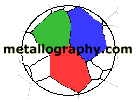

|
Figure 14. Fully ferritic matrix (note ferrite grain boundaries) of a ductile iron specimen etched with 4% nital, 100x. |

|
Figure15. Ductile iron specimen with substantial amounts of ferrite and pearlite etched with 4% nital, 100x. |

|
Figure 16. Ductile iron specimen with a pearlitic matrix and a small amount of ferrite surrounding the nodules etched with 4% nital, 100x. |
| Go to: | [FAQ] | [Home] | [Beginning of Article] |